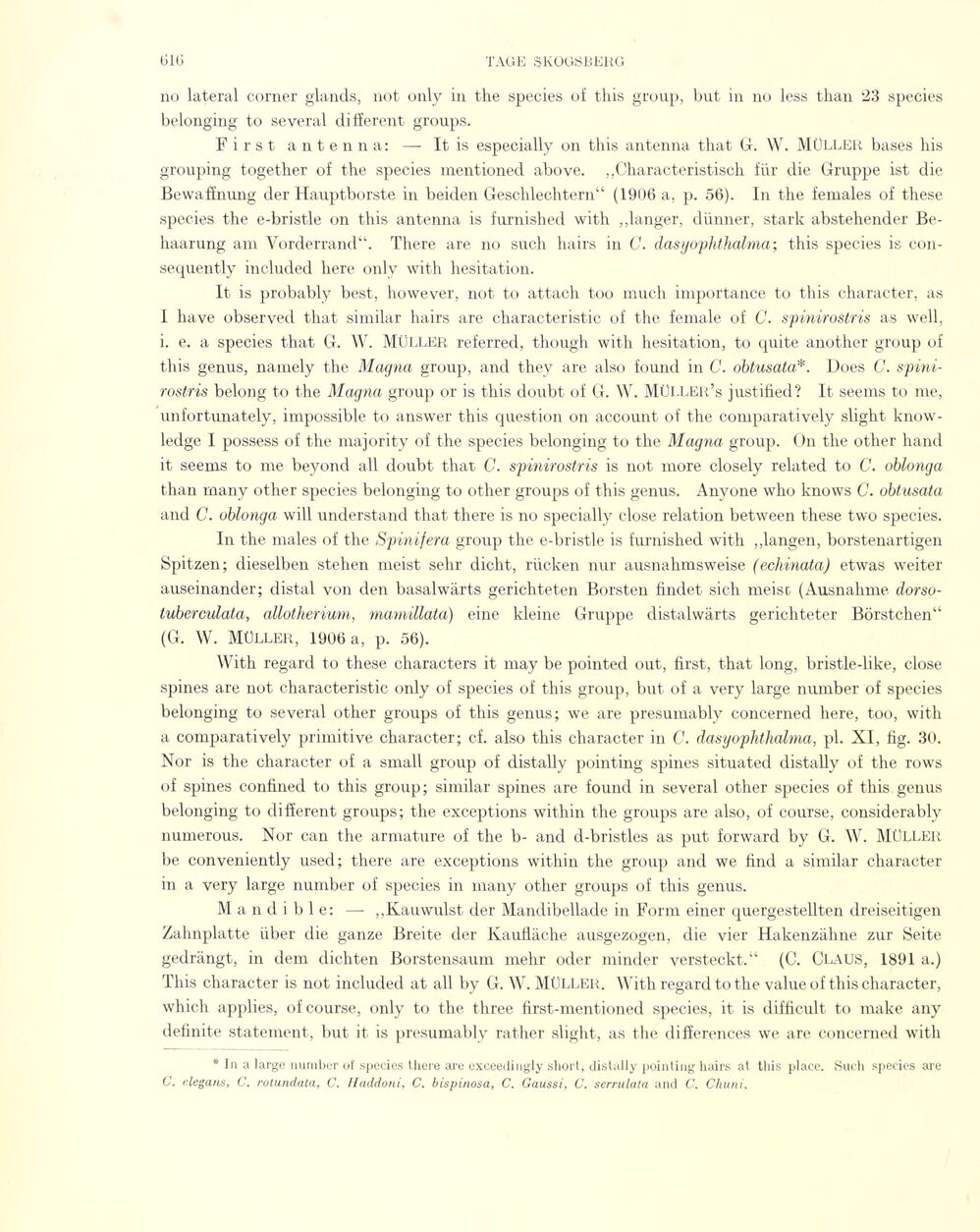
Full resolution (JPEG) - On this page / på denna sida - Sidor ...

<< prev. page << föreg. sida << >> nästa sida >> next page >>
Below is the raw OCR text
from the above scanned image.
Do you see an error? Proofread the page now!
Här nedan syns maskintolkade texten från faksimilbilden ovan.
Ser du något fel? Korrekturläs sidan nu!
This page has never been proofread. / Denna sida har aldrig korrekturlästs.
no lateral corner glands, not only in the species of this group, but in no less than 23 species
belonging to several different groups.
First antenna: — It is especially on this antenna that G. W. MÜLLER bases his
grouping together of the species mentioned above. „Characteristisch für die Gruppe ist die
Bewaffnung der Hauptborste in beiden Geschlechtern“ (1906 a, p. 56). In the females of these
species the e-bristle on this antenna is furnished with „langer, dünner, stark abstehender
Behaarung am Vorderrand“. There are no such hairs in G. dasyophthalma; this species is
con-sequently included liere only with hésitation.
It is probably best, however, not to attach too much importance to this character, as
I have observed that similar hairs are characteristic of the female of C. spinirostris as well,
i. e. a species that G. W. Müller referred, though with hésitation, to quite another group of
this genus, namely the Magna group, and they are also found in G. obtusata*. Does C.
spini-rostris belong to the Magna group or is this doubt of G. W. MÜLLer’s justitied? It seems to me,
unfortunately, impossible to answer this question on account of the comparatively slight
knowledge I possess of the majority of the species belonging to the Magna group. On the other hånd
it seems to me beyond all doubt that C. spinirostris is not more closely related to C. oblonga
than rnany other species belonging to other groups of this genus. Anyone who knows C. obtusata
and C. oblonga will understand that there is no specially close relation between these two species.
In the males of the Spinifera group the e-bristle is furnished with „langen, borstenartigen
Spitzen; dieselben stehen meist sehr dicht, rücken nur ausnahmsweise (echinata) etwas weiter
auseinander; distal von den basalwärts gerichteten Borsten findet sich meist (Ausnahme
dorso-tuberculata, allotherium, mamillata) eine kleine Gruppe distalwärts gerichteter Börstchen“
(G. W. Müller, 1906 a, p. 56).
With regard to these characters it may be pointed out, first, that long, bristle-like, close
spines are not characteristic only of species of this group, but of a very large number of species
belonging to several other groups of this genus; we are presumably concerned here, too, with
a comparatively primitive character; cf. also this character in C. dasyophthalma, pl. XI, fig. 30.
Nor is the character of a small group of distally pointing spines situated distally of the rows
of spines confined to this group; similar spines are found in several other species of this genus
belonging to different groups; the exceptions within the groups are also, of course, considerably
numerous. Nor can the armature of the b- and d-bristles as put forward by G. W. MÜLLER
be conveniently used; there are exceptions within the group and we find a similar character
in a very large number of species in many other groups of this genus.
M a n d i b 1 e: — „Kauwulst der Mandibellade in Form einer quergestellten dreiseitigen
Zahnplatte über die ganze Breite der Kaufläche ausgezogen, die vier Hakenzähne zur Seite
gedrängt, in dem dichten Borstensaum mehr oder minder versteckt.“ (C. CLAUS, 1891 a.)
This character is not included at all by G. W. MÜLLER. With regard to the value of this character,
which applies, of course, only to the three first-mentioned species, it is difficult to make any
definite statement, but it is presumably rather slight, as the differences we are concerned with
* In a large number of species there are exeeedingly short, distally pointing hairs al this place. Such species are
C. elegans, C. rotundata, C. /iaddoni, C. bispinosa, C. Gaussi, C. serrulata and C. Chuni.
<< prev. page << föreg. sida << >> nästa sida >> next page >>